Leonard Splaine Best Air Conditioner for your home – Trane vs Carrier vs Lennox Air Conditioner Review 2022
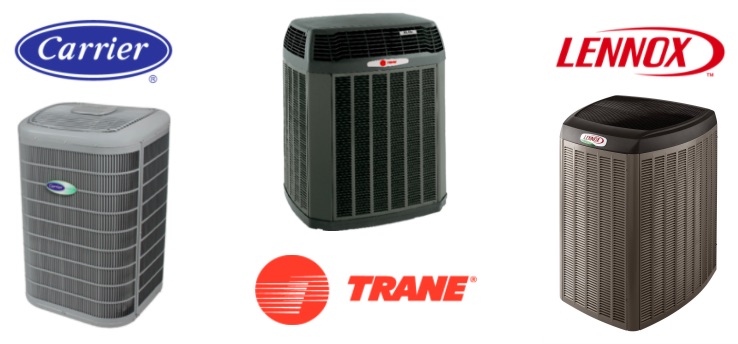
There are a few main things that homeowners will want to take into consideration when deciding which of the best AC units they should install in their homes. It really depends on what you value the most in a top brand central air conditioner. The major factors for most homeowners will be the total cost to install the best air conditioner brands, lifespan of the AC unit, warranties, energy efficiency (SEER ratings), and size of the unit you need for your home’s square footage (TONS) to efficiently cool your home.
So, straight to the point…who makes a better air conditioner, Trane or Carrier or Lennox? Which air conditioning brand to choose is a hotly debated topic in the HVAC industry, and no question gets asked more often than “what’s the best AC brand?” Per your request, today we will discuss three of the biggest AC brands in our Trane vs Carrier vs Lennox air conditioner review. In this guide, we shall dig into the differences and comparison between these brands, so you’ll have an objective set of criteria for choosing one of them.
What Trane, Carrier and Lennox ACs Have in Common
Before we start our Trane vs Carrier vs Lennox air conditioner review, it is important noting how much Lennox, Carrier and Trane have in common.
- All sell air conditioners in tiers that could be considered “basic, better and best.”
- Top models have WiFi-connected, touchscreen thermostats available.
- Most have compressor sound-reduction insulation.
- Mid-range and top models have down-slanted / louvered cabinet vents on most models to protect the coil from yard hazards like a stone thrown by a lawnmower.
- They use R-410A refrigerant, which Carrier calls Puron.
- AC cabinets are finished in powder-coat, baked-on enamel for better resistance to corrosion.
Trane vs Carrier vs Lennox AC Differences
While there are plenty of similarities between these brands, there are also distinct differences as well. In this Trane vs Carrier vs Lennox AC review, we will discuss these three brands from 5 different aspects: efficiency, performance and features, repairs and reliability, and finally, cost.
1. Energy Efficiency
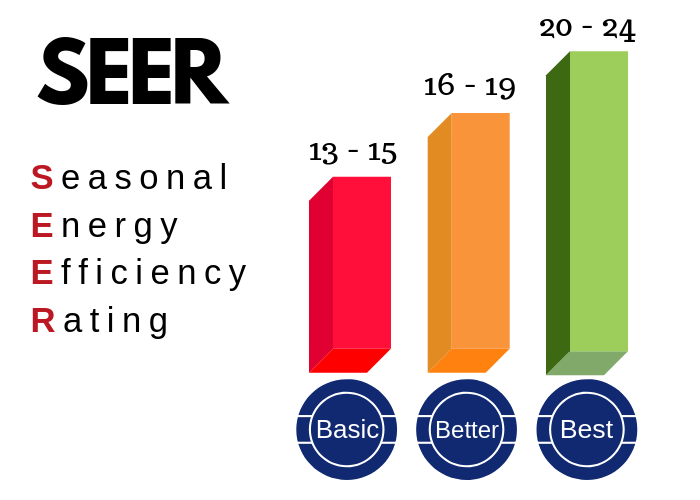
Lennox is the leading brand here, as we’ve mentioned, its economy brand is Ducane. The brand invests heavily in the development of efficient equipment – ACs and heat pumps, furnaces and Lennox SunSource PVC solar panels to power systems. Trane follows. Carrier once offered the most efficient AC and heat pumps, but now is third in this list.
Here are the three most efficient models from each brand:
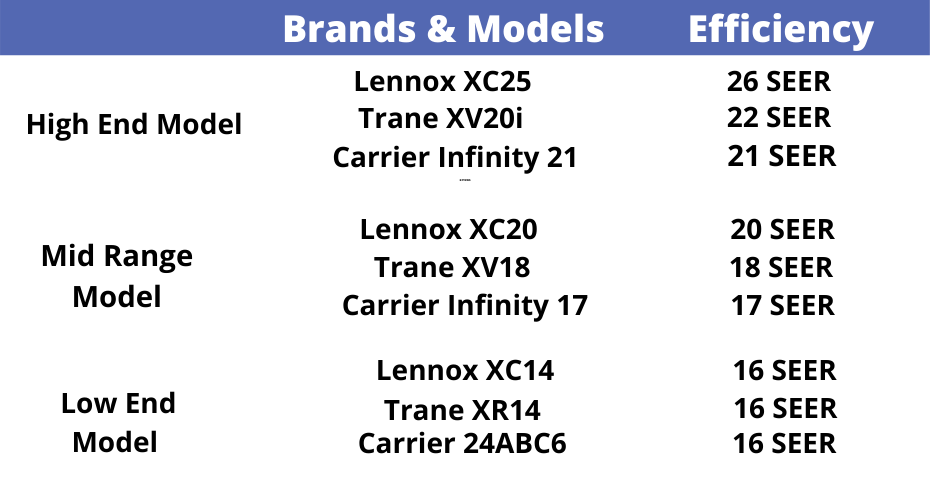
The table shows that Lennox offers the most options for super-high efficiency, and the gap is quite significant. When homeowners are choosing eco-friendly equipment that also significantly reduces energy use, Lennox is ahead of the pack. And it’s not just Carrier and Trane; Lennox leads all brands of standard split system central air conditioners. You would have to choose to mini-split or geothermal systems to get higher SEER ratings.
2. Features
Next in our air conditioner review, we will spend some time discussing the performance and features offered by each brand. Here are the notable features for each:
- Humidity control: Removing excess humidity in warm weather allows a home to be comfortable at a higher temperature.
- Variable fan: A variable fan in the AC condensing unit speeds up and slows down to match the output of its variable capacity. The main advantage is quieter operation at low capacities.
- Smart thermostat: These thermostats allow you to monitor and control your HVAC system using an Android or iOS device and the app.
- Smart home compatibility: These thermostats also integrate with a range of home automation systems and devices. Nexia allows you to control all smart home equipment from a single app. Cor is Carrier/United Technology’s home automation system that controls HVAC of any brand, home security and home safety using a hub, app, Cor thermostat and a range of sensors. Alexa is the operating platform for Amazon’s Echo.
- Communicating technology: Communicating technology allows system components to share information, rather than information flowing one way from the thermostat to the components to turn on, what stage to run on, and to turn off. If you want a communicating AC, the entire system must be matched, meaning the top of the line AC, furnace (or heat pump and air handler) and thermostat. This usually means the replacement of the entire heating and air conditioning system.
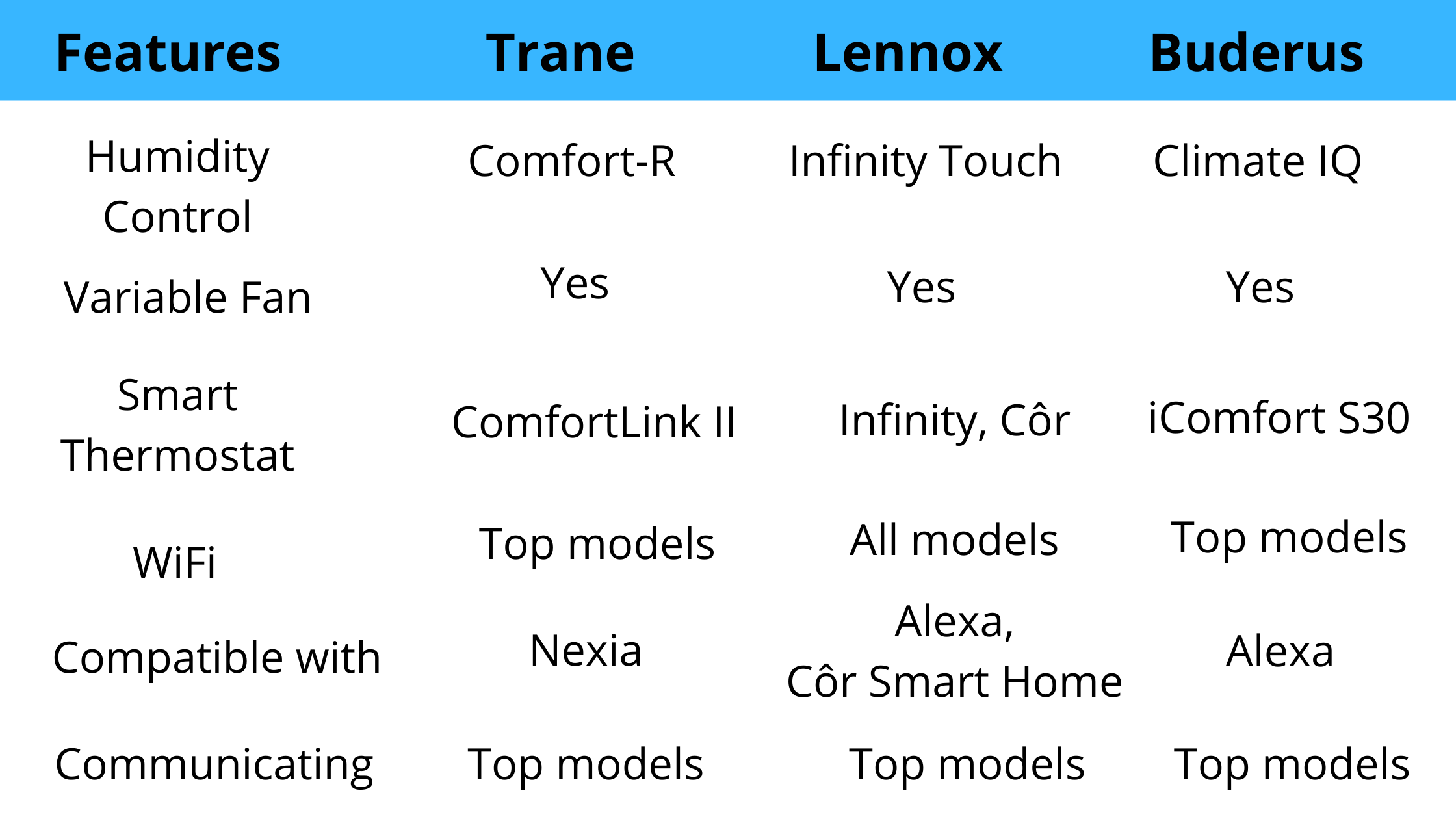
3. Repairs
It is important to understand that any piece of machinery will break down, from time-to-time. The average lifespan of your Carrier or Lennox or Trane air conditioner is between 10 and 15-years. Very few Trane, Lennox and Carrier central air conditioners go 15-20 years without needing repair, whether minor or major. There are potential issues worth considering. Here’s a summary for each brand:
Carrier: Parts are widely available and reasonably priced. Here’s where Carrier and United Technologies really set themselves apart from Trane and Lennox AC units…repairs. Carrier is the best brand to own if repairs are needed.
Trane: In some areas, Trane parts cost more. The issue seems to be that some supply houses that sell wholesale to HVAC companies only stock Trane OEM parts rather than generic parts that cost less. In short, repairs on a Trane AC might cost more. This is more likely in small towns and rural communities than in large metro areas.
Lennox: For years, HVAC contractors and unhappy homeowners complained about Lennox repairs. Lennox primarily requires Lennox parts for repairs. Most generics won’t work. Secondly, the Lennox supply chain was notoriously slow, so a repair that could be done same-day/next-day on another brand sometimes took a week or two on a Lennox. We have found this to not be a major issue when it comes to the services Lennox equipment that we install. As a Lennox Premier dealer, we get priority service and pricing on all equipment and replacement parts making the equipment.
Starting in early 2015, Lennox began overhauling its supply chain for the 110,000 parts in its inventory. In June 2015, Lennox claimed, “Immediate fill rate is up 15 percent to 93 percent and 98 percent of demand can be delivered by the next morning (up from 35 percent in 2008).”
Some HVAC contractors aren’t so sure. In May 2016, Timothy Kautz said on the ASM blog, “Lennox Parts are Hard to Find – Whereas their competitors, including Trane, provide extensive logistics chains, Lennox is completely proprietary and does not. In fact, their supply chain is downright horrible.”
Our advice is to choose, as we’ve said twice already, a dealer that sells at least two of the brands. If Lennox is one of them, ask them if Lennox parts are easy to get. Now that you know the background, you’ll be able to evaluate whether the person is being honest with you or trying “to sell you something.”
4. Variable- Capacity Performance

There are only slight differences in the performance of these brands. Each makes single-stage, two-stage, and variable-capacity models. The variable-capacity air conditioners are also called variable-speed or modulating. The industry is starting to borrow the term “inverter technology” too from mini-split technology.
Variable-capacity units change capacity or speed in small increments to precisely meet the cooling demand in your home.
- The Carrier Infinity 19VS has 5 speeds from 25% to 100%. The 25% is the lowest and quietest. The 5 speeds are the least and represents a jump of 18.75% per speed.
- The lowest capacity of the Trane XV20i is 30%, and Trane says it modulates in .1% increments and has 700 speeds. This offers the most balanced air conditioning.
- The Lennox XC25 ranges from 35% to 100% and has 65 speeds. That means in changes capacity in 1% increments. Lennox variable-capacity compressor is made by LG and uses inverter technology. This compressor has an excellent track record.
Is the difference noticeable? A unit running at 25% capacity is 5-7 decibels quieter than one running at 35%, so you might notice a slight difference if you were near the outside unit. It’s doubtful it would make a difference to noise heard indoors with the windows closed. The differences in cooling precision and balance will be noticed by the most sensitive to temperature changes, but the average homeowner will be as happy with the Carrier Infinity model as the Trane or Lennox ACs, in our opinion based on consumer research.
5. Price Comparison
Like any other product, these HVAC manufacturers price-check the competition and seek to be competitive on cost. Lennox, Carrier and Trane sell most units only through their authorized dealers. You can’t shop prices at online wholesalers, for example. You must get estimates from local dealers that sell you the package of equipment and installation.
How do Lennox, Carrier and Trane compare on cost? It depends on who you talk to.
HVAC contractor Timothy Kautz of ASM in California believes that Lennox is a costlier brand. Kautz writes, “Lennox is More Expensive than Trane – Despite having a horrible logistics chain, Lennox is also more expensive than their competitors for comparable level equipment.” We have more later about the supply chain issue Lennox is fighting.
In our experience, Lennox has slightly to moderately higher prices than the others. Part of this is the superior efficiency that Lennox offers in each tier. It sells the most efficient models in the three performance tiers: Variable-capacity (XC25 is 26 SEER), two-stage (XC21 is 21 SEER, tied with the Carrier Infinity 21) and single-stage (SL 18XC1 is 18.5 SEER).
How much more expensive is Lennox than Trane and Carrier?
It depends on what models you’re comparing. Lennox’s top models will be 10-20% higher. In the low and middle tiers, prices are sometimes higher, but can be lower too. Some of the price differentials is determined by who you are getting estimates from:
1). Large HVAC contractors buy more equipment from manufacturers/distributors, so often get a volume discount that they use to beat the competition on price. It’s possible that a contractor like Kautz doesn’t get better deals on Lennox because he doesn’t buy enough of them.
2). HVAC contractors willing to sell just one brand of equipment often get better wholesale costs than non-exclusive sellers.
Our recommendations for getting the best prices on good equipment and proper installation:
- First, get estimates from several contractors in your area that sell the equipment you’re interested in buying. Let them know they are competing for the job, but are willing to pay for installation done properly.
- Secondly, choose contractors for your estimates that sell at least two of the brands. This makes a difference.
- The lowest bid is often achieved by cutting corners on the job – perhaps even installing cheaper equipment than was promised in the estimate.
- On the other end, the highest bid is usually from a busy contractor that doesn’t care whether it gets your business – but if it does, it’s going to maximize its profit unfairly.
- So, in most cases, the middle price is usually the fair one.
Choosing an Air Conditioner Contractor
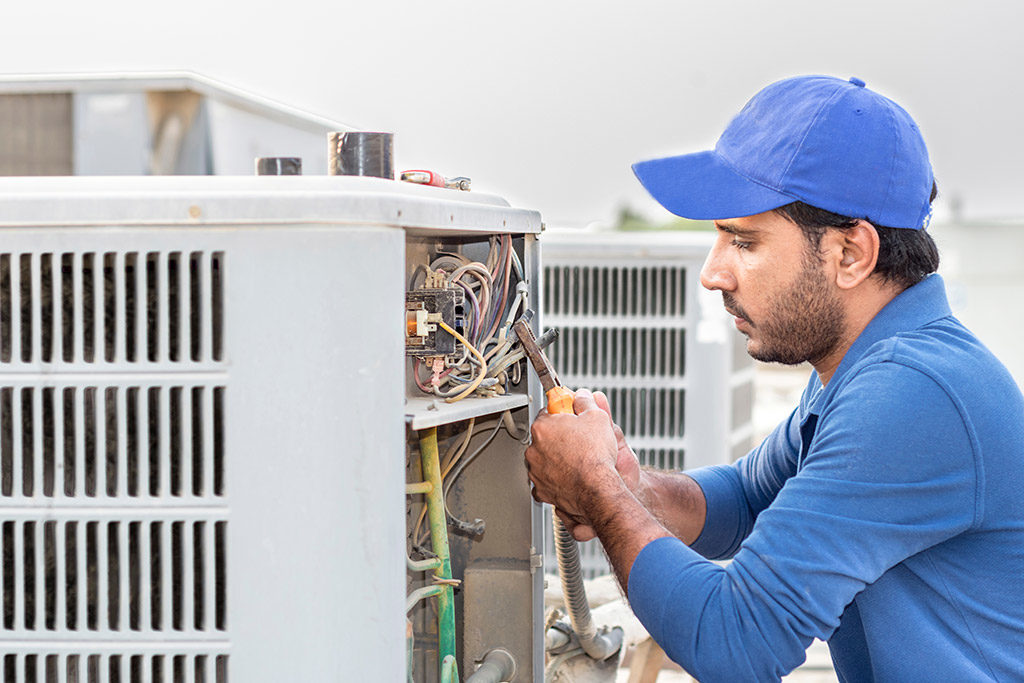
Choosing a good contractor to install a new central air conditioner can be as important as the equipment you choose, because proper installation and maintenance are needed for the equipment to operate safely, reliably, and at maximum efficiency.
Selecting a contractor may be the essential task of buying a brand-new central air system. Ask potential contractors for current reference. If you are changing your central air conditioning conditioner, inform your service provider exactly what you like and don’t like about the older system. If the arrangement failed, ask the expert to discover out why. The very best time to take care of existing issues is when a new system is being set up.
When creating your brand-new air conditioning system, the professional you select need to:
- Make use of a composed computation procedure or computer system program to size the air conditioner;
- Supply a written agreement listing the bottom lines of your setup that includes the outcomes of the cooling load computation;
- Offer you a written service warranty on gear and workmanship.
- Prevent making your choice solely on the basis of cost. The quality of the repair ought to be your greatest top priority, due to the fact that quality will identify energy expense, convenience, and resilience.
A quality, properly installed, efficiently operating air conditioning system is critical to your comfort and cost of operation and maintenance. That’s why it is important for you to hire a state licensed air conditioning contractor. They can do the job right, with the right parts and equipment and at the most efficient cost.
When you contact us today from our website, you will receive our A+, licensed, and insured HVAC installers certified by Trane, Carrier and Lennox to install their equipment in your area. Our pricing and rates are fair and made with integrity.
